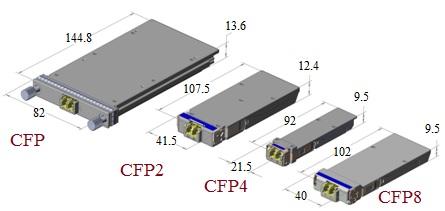CFP vs QSFP28 Transceivers: Key Differences and Specifications
Advertisement
This article breaks down the differences between CFP and QSFP28 transceivers, covering their specifications, applications, and more.

Figure 1: Dimensions of CFP, CFP2, CFP4, and CFP8

Figure 2: Dimension of QSFP28
Here’s a detailed comparison in table format:
| Specifications | CFP | QSFP28 |
|---|---|---|
| Line rate | 40/100 G | 4 x 25 -28G |
| Hot pluggable | YES | YES |
| Dimensions (W x L x H, mm) | 82 x 145 x 14 | 18 x 52 x 8.5 |
| Electrical interface | CAUI, XLAUI, SFI-5, SFI-5.2 CPPI-4 | CPPI-4 |
| Max. power | 3 to 18 W | 3.5 W |
| Applications | Ethernet, SONET/SDH, OTN | InfiniBand, Ethernet |
| Front panel density (1 RU) | 4 ports | 22/44 ports |
| Media | MMF, SMF | MMF, SMF |
| Electrical signaling in Gb/s | 10 x 10 CAUI-10 | 4 x 25 CAUI-4 |
Advertisement
 RF
RF

